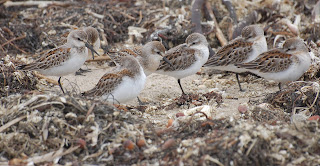Pescadero is lovely! I visited for the third week in a row. This time we headed straight for the marshes.

The marshes are quite beautiful and you can find all sorts of birds there. Today we saw a song sparrow, an egret, a turkey vulture, several red-tailed hawks, common mergansers, seagulls, swallows, and a great blue heron. I also heard several chickadees and a very disgruntled crow.
We're walking back along the trail to head home, and I see this big blue beast.
A great blue heron! Look at his yellow eye.

He was looking a bit scruffy, which is to be expected at the end of breeding season. Great blue herons breed from March to May.
He wasn't at all scared by us. Instead, he watched us carefully and slowly walked off. Great blue herons are four feet tall and have a six foot wingspan, so he has no reason to be intimidated by mere humans.
Below you can see the thickness of the marsh water.

These marshes also include a breeding ground for the herons, called a rookery. From a distance, it doesn't look like much of anything.

But each of those gray spots is a nesting site. They nest together to protect against predators.

I can't wait to visit a rookery next spring; the noise made by up to 135 great blue herons is supposed to be quite remarkable.
In other news, I set a hummingbird feeder out awhile ago and a few days ago I saw a hummer drinking from it! Success.
 To this!
To this! The double-crested cormorant is quite common where I live, which I now know thanks to my new lens. I've seen brandt's cormorants and pelagic cormorants in Monterey, CA, but I'm partial to the double-crested cormorant because of their green eyes and hooked beak.
The double-crested cormorant is quite common where I live, which I now know thanks to my new lens. I've seen brandt's cormorants and pelagic cormorants in Monterey, CA, but I'm partial to the double-crested cormorant because of their green eyes and hooked beak. Cormorants catch fish by diving up to 30 feet.
Cormorants catch fish by diving up to 30 feet. Although there is no mention of this in the guidebooks, the cormorants travel with pelicans while fishing. I can prove it:
Although there is no mention of this in the guidebooks, the cormorants travel with pelicans while fishing. I can prove it:
















 I really like the lighter brown feathers on their wings. They look distinct in the above picture, but against other backgrounds, the brown helps them blend completely.
I really like the lighter brown feathers on their wings. They look distinct in the above picture, but against other backgrounds, the brown helps them blend completely. Western Sandpipers eat aquatic insects, worms, small mollusks, and crustaceans from shallow water. The sandpipers to the left of the gull above are searching for food.
Western Sandpipers eat aquatic insects, worms, small mollusks, and crustaceans from shallow water. The sandpipers to the left of the gull above are searching for food.
























 They were really busy today. They were searching for food, calling to each other, disappearing inside the rocks. I suspect that they're raising babies right now. They feed their babies throughout the day to reduce the time it takes for the babies to fledge.
They were really busy today. They were searching for food, calling to each other, disappearing inside the rocks. I suspect that they're raising babies right now. They feed their babies throughout the day to reduce the time it takes for the babies to fledge.
 You see that face? That's the face of a bird with resolve. He will not show you his feet.
You see that face? That's the face of a bird with resolve. He will not show you his feet.


